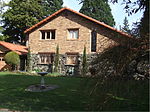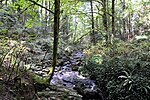Oregon Iron Company Furnace
1866 establishments in OregonBuildings and structures in Lake Oswego, OregonIndustrial buildings and structures on the National Register of Historic Places in OregonIndustrial buildings completed in 1866Industrial furnaces ... and 2 more
National Register of Historic Places in Clackamas County, OregonWikipedia Student Program

The Oregon Iron Company Furnace, or Oswego Iron Furnace, is an iron furnace used by the Oregon Iron Company, in Lake Oswego, Oregon's George Rogers Park, in the United States. The structure was added to the National Register of Historic Places in 1974 and underwent a major renovation in 2010. The current furnace is the only structure that remains of the original iron company, and is the oldest industrial landmark in the state of Oregon.
Excerpt from the Wikipedia article Oregon Iron Company Furnace (License: CC BY-SA 3.0, Authors, Images).Oregon Iron Company Furnace
Willamette Greenway,
Geographical coordinates (GPS) Address Nearby Places Show on map
Geographical coordinates (GPS)
| Latitude | Longitude |
|---|---|
| N 45.410983333333 ° | E -122.6607 ° |
Address
Oregon Iron Company Furnace
Willamette Greenway
97036
Oregon, United States
Open on Google Maps









